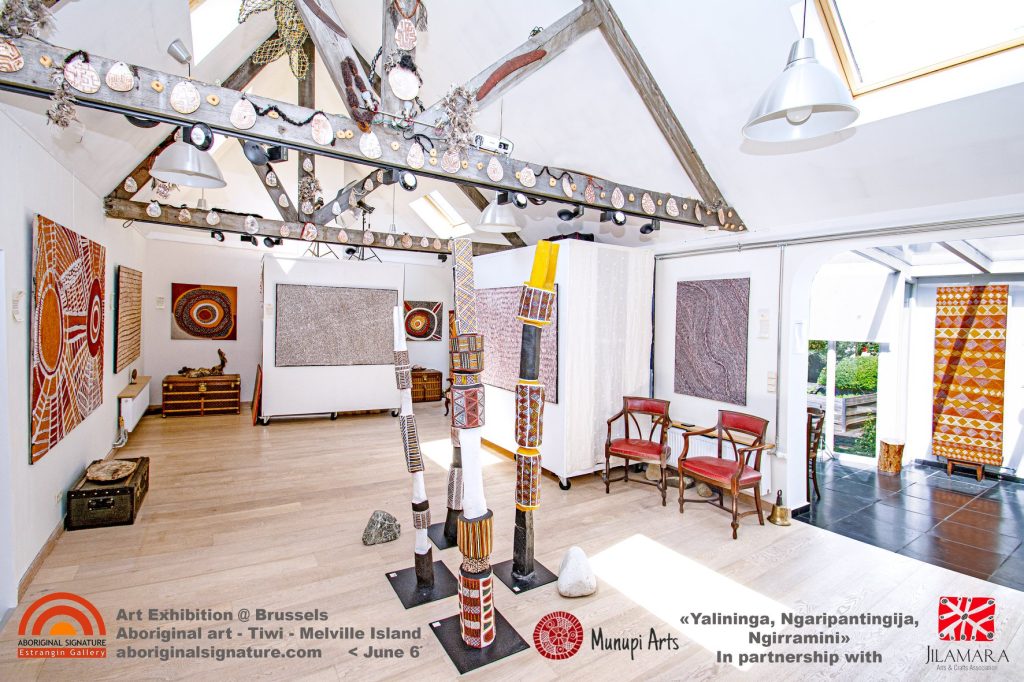Yalininga, Ngaripantingija, Ngirramini • Aboriginal Art of Melville Island: Aboriginal Signature Estrangin, Brussels Belgium
Johnathon World Peace Bush
13 May - 6 Jun 2020
Yalininga, Ngaripantingija, Ngirramini • Aboriginal Art of Melville Island – Tiwi
Aboriginal Signature Estrangin, Brussels Belgium
The title of the exhibition in Brussels highlights the very essence of the Aboriginal people of the Tiwi Islands. With three fundamental words, chosen by the leaders Pedro Wonaeamirri and Carol Puruntatameri, we cross time and space. With their artistic communities of Munupi and Jilamara , they invite us to the heart of the spiritual ceremonies of Melville Island, in the far north of Australia.
YILANINGA
The time has come to bring the whole community together and prepare the ceremonies together. The cries of children echo all around. The excitement shared by all generations is at its height. Adults and young teenagers adorn their faces and bodies for pukumani and kulama ceremonies, with ocher colors, such as yalinga (red), arrikininga (yellow) and tutyangini (white).
Some tones go beyond the use of primordial pigments, adopting the practice of mixing ochres to create subtle pinks and purples as with the great artists Alison Puruntatameri and Delores Tipuamantumirri.
NGARIPANTINGIJA
The geometric patterns placed on the bodies command everyone’s admiration. Very young children also ask to be part of it, in an attractive and moving transmission dynamic. The painted forms will soon come to life on their skin during ritual dances. In turn, the initiates are ready to embrace the scene to the sound of deep voices and sequenced footsteps in the rising red dust all around. Their supple skin vibrates, shines, and sublimates the codified forms under the evening light.
NGIRRAMINI
The procession now approaches the large funeral poles (Tutinis), carved from ironwood, for Pukumani ceremonies, the culmination of ritual mourning for a deceased person. The forked top represents the struggle between Purukuparli and his brother Taparra the lunar man. The rectangles, the diamond structures and the curved undulations, illustrate a form of feminine realization, in the quintessence of cult symbols.
Now the dancers come closer and wear cacatua warra feathers in their hair, with bark bracelets and fake beards. With the elders, they all together sing the cycles of immemorial songs, whose deep sounds reverently evoke the totems and ceremonial dreams of the participants, like a sound imprint carried since the dawn of time.
We are very honored to welcome to Brussels 40 sublime Tiwi paintings and sculptures, patiently selected for this exhibition by the gallery, in partnership with the artistic communities of Munupi and Jilamara.
From the antipodes, the songs and ceremonial dances of the 20 artists in the exhibition resonate here in Europe, through their body motifs placed on the linen of the canvases and the iron wood of the Tutinis. The latter with their 600 kg, crossed 17,000 km to reach us in the capital of Europe. A few months earlier, they were exhibited in Australia, in the Adelaide Museum as part of the great Tarnanthi festival.

